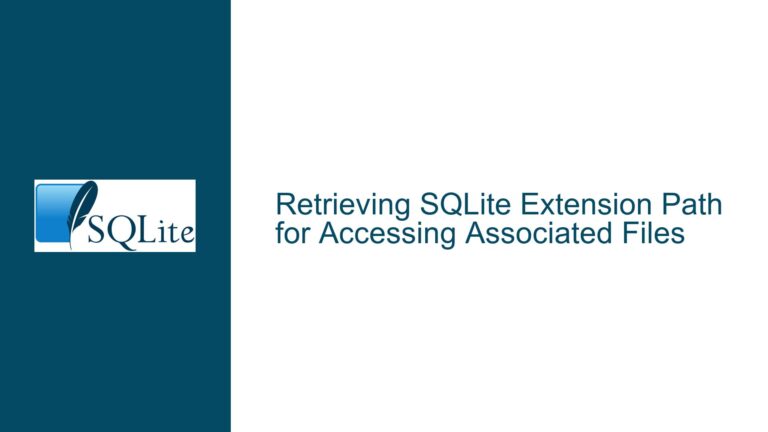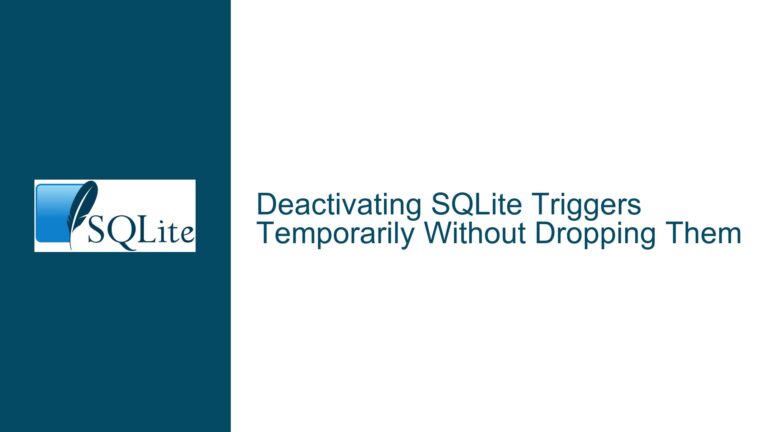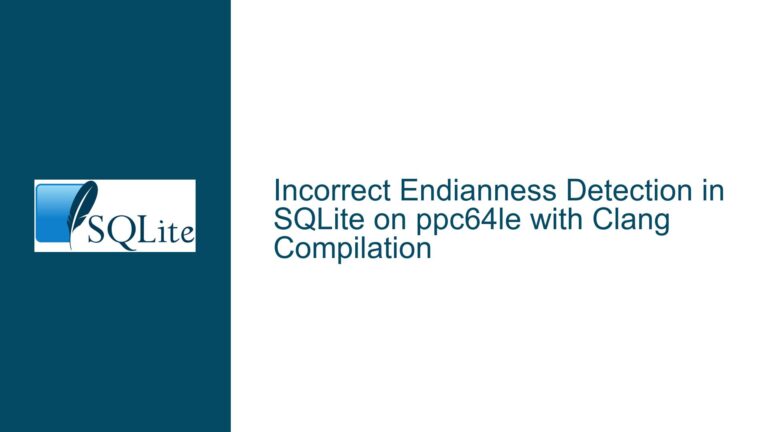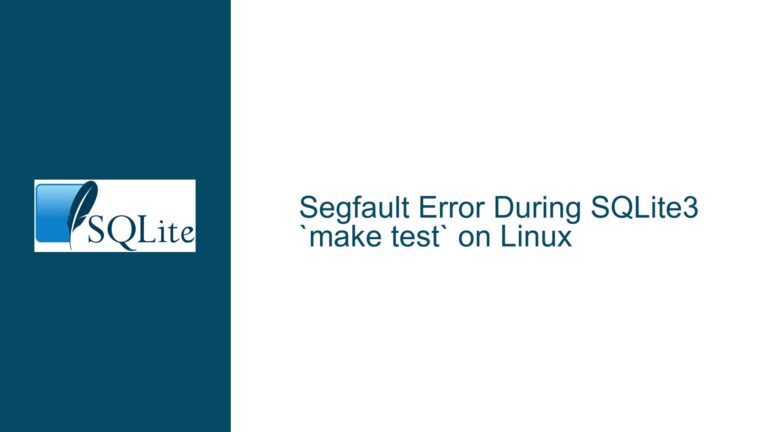Segfault in SQLite3 Mutex Initialization When Called from Library
Issue Overview: Segfault in sqlite3_mutex_enter Due to Uninitialized Mutex Configuration
The core issue revolves around a segmentation fault occurring when calling sqlite3_mutex_enter from a library context, specifically when the SQLite3 library is accessed through a wrapper like sqlite_orm. The fault manifests only when the SQLite3-related code is moved from the main executable into a separate library, even though the same code works flawlessly when executed directly from the main executable. The segmentation fault is traced to the sqlite3GlobalConfig.mutex.xMutexEnter function, where the mutex configuration (sqlite3Config.mutex) appears to be uninitialized or reset to 0x0 when accessed from the library context.
The problem is particularly perplexing because the mutex configuration is correctly initialized and functional when the same code is executed from the main executable. This suggests that the issue is not with the SQLite3 library itself but rather with how the library is being linked or initialized in the context of a shared library. The behavior is consistent across single-threaded and multi-threaded scenarios, ruling out thread-safety issues as the root cause.
Further investigation reveals that the sqlite3Config object appears to have two distinct instances in memory when accessed from the library versus the main executable. This duality suggests that multiple copies of the SQLite3 library might be linked into the application, leading to conflicting global configurations. The issue is exacerbated when using CMake to manage the build process, as the linking behavior of shared libraries can introduce subtle differences in how global symbols are resolved.
Possible Causes: Multiple Copies of SQLite3 Linked into the Application
The most plausible cause of the segmentation fault is the presence of multiple copies of the SQLite3 library within the application. This situation can arise due to several factors, including improper CMake configuration, static linking of SQLite3 in multiple libraries, or conflicting visibility settings for global symbols.
1. Improper CMake Configuration
CMake’s handling of shared libraries and interface targets can lead to unintended linking behavior. In this case, the database_manager interface target is linked to sqlite_orm, which in turn depends on SQLite3. If the database_manager target is marked as INTERFACE or SHARED, it may propagate its dependencies differently than expected, leading to multiple instances of SQLite3 being linked into the final executable. This is especially problematic if sqlite_orm or another library statically links SQLite3, as static linking can result in duplicate global symbols.
2. Static Linking of SQLite3
Static linking of SQLite3 in multiple libraries can cause each library to have its own copy of the SQLite3 global configuration (sqlite3Config). When these libraries are linked into the same application, the global configuration becomes fragmented, leading to inconsistent mutex initialization. This is a common issue when using third-party libraries that embed SQLite3 internally, as they may not account for the possibility of multiple SQLite3 instances in the same process.
3. Conflicting Visibility Settings
The visibility of global symbols in shared libraries can also contribute to the problem. If the SQLite3 symbols are not properly exported or hidden, the dynamic linker may resolve them differently in the main executable versus the library context. This can result in the sqlite3Config object being initialized differently depending on where it is accessed, leading to the observed segmentation fault.
4. Library Initialization Order
The order in which libraries are initialized can also play a role. If the SQLite3 library is initialized after the sqlite_orm wrapper, the global configuration may not be set up correctly when the wrapper attempts to use it. This is particularly relevant when using shared libraries, as the dynamic linker may not guarantee a specific initialization order.
Troubleshooting Steps, Solutions & Fixes: Resolving Multiple SQLite3 Instances and Ensuring Proper Initialization
To resolve the segmentation fault, the following steps can be taken to ensure that only a single instance of SQLite3 is linked into the application and that the global configuration is properly initialized.
1. Audit CMake Configuration
Review the CMake configuration to ensure that SQLite3 is linked consistently across all targets. Specifically, check the target_link_libraries directives for the database_manager, sqlite_orm, and any other libraries that depend on SQLite3. Ensure that SQLite3 is linked as a PRIVATE dependency unless it is explicitly required to be exposed to other libraries.
target_link_libraries(database_manager PRIVATE sqlite_orm)
If sqlite_orm internally links SQLite3, ensure that it does so in a way that avoids duplicate symbols. This may involve modifying the sqlite_orm build configuration or using a shared library for SQLite3.
2. Use a Shared SQLite3 Library
To avoid multiple copies of SQLite3, consider using a shared library for SQLite3 instead of static linking. This ensures that all parts of the application use the same instance of SQLite3 and its global configuration. Update the CMake configuration to link against the shared library:
find_package(SQLite3 REQUIRED)
target_link_libraries(database_manager PRIVATE SQLite::SQLite3)
3. Check for Embedded SQLite3 Copies
Inspect all third-party libraries used in the project to determine if any of them embed SQLite3 internally. If a library includes its own copy of SQLite3, consider modifying its build configuration to use the shared SQLite3 library instead. Alternatively, ensure that the embedded copy is compatible with the rest of the application.
4. Verify Symbol Visibility
Ensure that the SQLite3 symbols are properly exported in the shared library. This can be done by adding the appropriate visibility attributes to the SQLite3 build configuration. For example, when building SQLite3 from source, use the -fvisibility=hidden flag to hide internal symbols and explicitly export only the public API.
5. Use Address Sanitizer and Debug Symbols
Compile the application with address sanitizer and debug symbols to gain more insight into the memory layout and symbol resolution. This can help identify where the duplicate SQLite3 instances are being introduced and how the global configuration is being initialized.
cmake -DCMAKE_BUILD_TYPE=Debug -DSQLITE_DEBUG=ON -UNDEBUG ..
make
6. Trace Library Initialization
Use tools like LD_DEBUG to trace the initialization of shared libraries and the resolution of global symbols. This can help identify any discrepancies in how SQLite3 is being initialized in the main executable versus the library context.
LD_DEBUG=all ./your_application
7. Minimize and Reproduce the Issue
Create a minimal reproducible example that isolates the issue. This can help identify the exact conditions under which the segmentation fault occurs and simplify the debugging process. Use tools like cvise to automatically minimize the code while preserving the issue.
8. Consult SQLite3 Documentation
Refer to the SQLite3 documentation on how to corrupt an SQLite database for additional guidance on avoiding common pitfalls, including multiple copies of SQLite3 in the same application.
By following these steps, the segmentation fault caused by uninitialized mutex configuration can be resolved, ensuring that SQLite3 operates correctly in both the main executable and library contexts.





